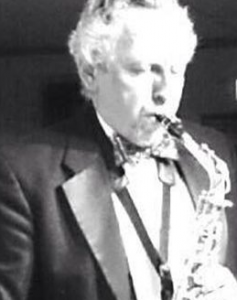St. Elizabeth Healthcare
As a professional musician and saxophone player, Ken Foltz loves spending a few hours jamming with a jazz combo in his friend’s living room or playing with his big band on a warm evening alongside the Ohio River.
He also enjoys restoring classic sports cars with friends and then taking a spin to see their work in action.
So, when Foltz found out he needed surgery to repair a heart valve, he knew he couldn’t put off the procedure. There’s too much music to play and lots of life to live.

Ken Foltz
“It knew it was something I didn’t want to mess around with. I needed to bite the bullet and get the surgery as soon as possible,” says the 67-year-old Foltz.
But thanks to the expertise at St. Elizabeth Healthcare, Foltz didn’t have to undergo highly invasive open-heart surgery. Instead, his team used a cutting-edge procedure that meant he would be back on his feet — and back to living life — only a few days after the procedure.
Warning signs
Foltz first noticed something wasn’t quite right when he was doing yard work last fall. He realized his stamina wasn’t what it used to be — the annual leaf cleanup took more out of him than usual.
“I just attributed it to my age and the fact that I had been spending more time sitting at home because of the pandemic,” Foltz says.
But then, one night earlier this year, Foltz was lying in bed when he noticed his heart had an irregular rhythm. It was also difficult to breathe when he was on his back.
Knowing that these were classic signs of a heart problem, Foltz made an appointment with his primary care physician as soon as possible. After an exam and EKG, Foltz’s doctor referred him to Dr. Kevin Miller, a Cardiologist with St. Elizabeth Heart & Vascular Institute, who scheduled an appointment and echocardiogram for the next day.
Within 24 hours, Foltz had confirmation that he needed to have his mitral valve repaired.
“Dr. Miller told me to go to the hospital — that it wasn’t an emergency but an urgency,” says Foltz.
A minimally invasive option
The team at St. Elizabeth Heart and Vascular Institute told Foltz about Mario Castillo-Sang, MD, a nationally recognized cardiac surgeon specializing in minimally invasive mitral valve repair. He has performed nearly 400 of these procedures.
“I was expecting I would need the typical open-heart surgery with the sternotomy. But the team brought in Dr. Castillo-Sang, who explained that he would be able to fix my heart valve without having to crack open my chest,” Foltz says. “When I heard of this option, I was tickled pink.”
With the minimally invasive approach, Dr. Castillo-Sang makes a one- to one-and-a-half-inch incision on the right side of the chest to access the heart. Using long, thin instruments, he repairs the valve flaps and reinforces it to prevent future leaks.
A serious condition that needs early intervention
Foltz was diagnosed with mitral valve prolapse, which meant the valve’s openings didn’t close properly and bulged into one of the heart’s chambers. When this happens, blood can move backward into the upper chamber, causing shortness of breath, fatigue and heart failure risk.

Dr. Mario Castillo-Sang
Dr. Castillo-Sang points out that there’s a misconception mitral valve leakage doesn’t hurt people. But the latest guidelines from the American Heart Association advocate for earlier intervention, so the heart doesn’t suffer serious damage. Dr. Castillo-Sang agrees.
“By repairing the valve before it needs to be replaced, the patient’s life expectancy resets to a person of the same age who doesn’t have heart valve issues,” he says. “Later intervention can help quality of life and comfort, but it doesn’t affect the bigger picture of prolonging life.”
Dr. Castillo-Sang also says that 40-50% of patients don’t have symptoms of a mitral valve problem, or if they do, they chalk it up to aging. That’s why patients must keep up regular visits with their PCPs, and doctors should make sure they’re asking the right questions during annual exams.
A faster road to recovery
Everything went smoothly during Foltz’s surgery and he was out of the hospital in just over 48 hours. It had been only 10 days since he first stepped in his PCP’s office, but he was already back home with a repaired valve and a new lease on life.
Because he underwent a minimally invasive procedure, Foltz didn’t experience the long-term hospital recovery and pain that can come with an open-heart operation. He “had no trouble with mobility” and, within a few weeks, started cardiac rehabilitation at St. Elizabeth Healthcare.
Although he’s still in rehabilitation, Foltz is already back to cutting the grass, working on cars and taking short walks. And best of all — he’s able to play the saxophone with no trouble at all. In fact, he already has a few gigs booked for the summer with his Cincinnati-area group, Swingtime Big Band.
Reflecting on his experience, Foltz is grateful for Dr. Castillo-Sang’s minimally invasive expertise, which allowed him to get back to doing what he loves faster. He also offers an essential piece of advice for fellow patients — don’t ignore your body.
“Pay attention to your body and be aware of any changes,” he says. “If you notice something different or unusual, don’t avoid it — go see your doctor.”
For more information about mitral valve repair procedures, visit stelizabeth.com or call 859-301-8287.
















